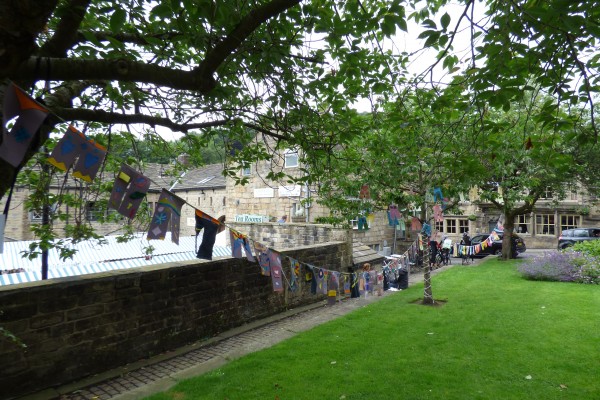10 Fascinating Facts about Funky Hebden Bridge
1. Hebden Bridge used to be known as Fustianopolis because many of its textile mills specialised in fustian – the generic name for corduroy and moleskin. Hebden Bridge has also been described as Trouser Town because it became an important centre for garment-making, especially working mens’ trousers made from fustian cloth.


Left: Canalside mill in Hebden Bridge. Right: Fustian cutter’s blade sculpture in St George’s Square
2. Hebden Bridge was one of the earliest towns to embrace the Co-operative Movement, just a few years after the Rochdale Pioneers. The Hebden Bridge Fustian Manufacturing Society, based in Nutclough Mill, was the first co-operative mill in the UK. Community spirit and co-operative principles still characterise the town. Hebweb was the first community website in the UK.


Left: Tower of Nutclough Mill. Right: Workers’ housing in Hebden Bridge
3. Until the 19th century Hebden Bridge was much smaller and more insignificant than Heptonstall, the small village on the top of the hill. Whereas Heptonstall had been a flourishing cloth-making centre for centuries, Hebden Bridge was little more than a bridging point over Hebden Water for packhorses en route to Heptonstall via the Buttress (an incredibly steep stone-paved track). But following the industrial revolution, everything changed. Hebden Bridge expanded rapidly and the Calder Valley became a hub for large water-powered and steam-powered textile factories.


Left: 16th century bridge crossing Hebden Water. Right: The Buttress
4. Because the Upper Calder Valley is so steep-sided, there’s very little space on the valley bottom for housing. When Hebden Bridge expanded during the 19th century, double-decker terraces were developed, consisting of underdwellings and overdwellings, running along the contours of the valley and up and down the slopes. ‘Flying freeholds’ – another Hebden Bridge novelty – were introduced as a result.

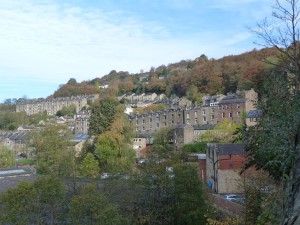
Double-decker terraces in Hebden Bridge
5. Hebden Bridge boasts the highest proportion of independent shops per capita in the country, a distinction it shares with Totnes in Devon. From butchers and bakers to designer-makers, Hebden Bridge combines traditional businesses, such as ironmongers, haberdashery and and florists, with craft lighting, jewellery and organic food. It’s no surprise the town was crowned Best Small Market Town in the Great British High Street Awards in 2016.




Independent shops in Hebden Bridge
6. Hebden Bridge’s thriving food and general market, held each thursday, recently won the national award for Best Small Outdoor Market in the UK. It sells everything from fresh fish, local cheese and sourdough bread to toiletries, plants and fruit and veg. Hebden Bridge also has a flea market each friday, an artisan’s market on saturday and a local produce market on sunday.




Hebden Bridge Market
7. Mytholmroyd-born poet Ted Hughes retained life-long connections with Hebden Bridge. His book Remains of Elmet (1979), a collaboration with photographer Fay Godwin, is all about the Upper Calder Valley. Hughes’s parents lived in a house called The Beacon at Slack, near Heptonstall. His wife, the American poet Sylvia Plath, who committed suicide in 1963, is buried in Heptonstall Churchyard. Lumb Bank, an 18th century millowner’s house in Colden Clough formerly owned by Ted Hughes, is now a flourishing creative writing centre run by the Arvon Foundation.


Left: Remains of Elmet. Right: Lumb Bank
8. Internationally renowned photographer Martin Parr lived and worked in Hebden Bridge during the mid 1970s at the start of his career. His photographs from this period, focusing on the non-conformist chapels that once dominated this area, were recently published in a book called The Non-Conformists.

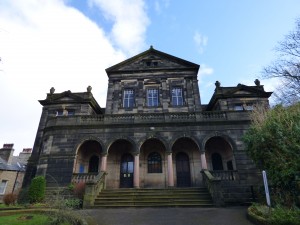
Left: Hope Chapel, Hebden Bridge. Right: Birchcliffe Chapel, Hebden Bridge


Left: Providence Chapel, Midgley. Right: Heptonstall Methodist Chapel
9. World-famous singer songwriter Ed Sheeran spent his formative early childhood years in Hebden Bridge and seems to have absorbed its quirky, independent spirit. His parents lived in a house on Birchcliffe Road in Hebden Bridge at the time. Ed’s father was a curator at Cartwright Hall in Bradford and his mother worked at Manchester City Art Gallery.

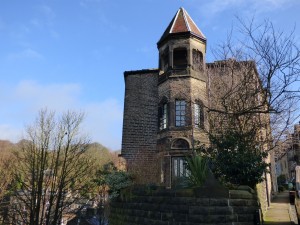
Left: West Royd (left), Ed Sheeran’s early childhood home on Birchcliffe Road, Hebden Bridge. Right: Eiffel Tower opposite West Royd
10. Hebden Bridge and the Calder Valley are popular locations for film and TV dramas, both historical and contemporary. The picturesque village of Heptonstall recently appeared in Jericho and Swallows and Amazons, while Holdsworth House, a 17th century house in Halifax, was an important location in Last Tango in Halifax. Hebden Bridge features prominently in Happy Valley, which, like Last Tango, was written by BAFTA award-winning screenwriter Sally Wainwright, who grew up in Calderdale. Catherine Cawood, the feisty police officer in Happy Valley played by Sarah Lancashire, lives in a house on Hangingroyd Road in the centre of Hebden Bridge.

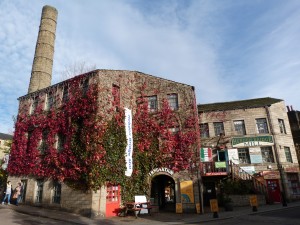
Hebden Bridge – key location for Happy Valley. Left: Bridge Gate. Right: Bridge Mill.


Heptonstall – key location for ITV’s series Jericho and the film Swallows and Amazons







